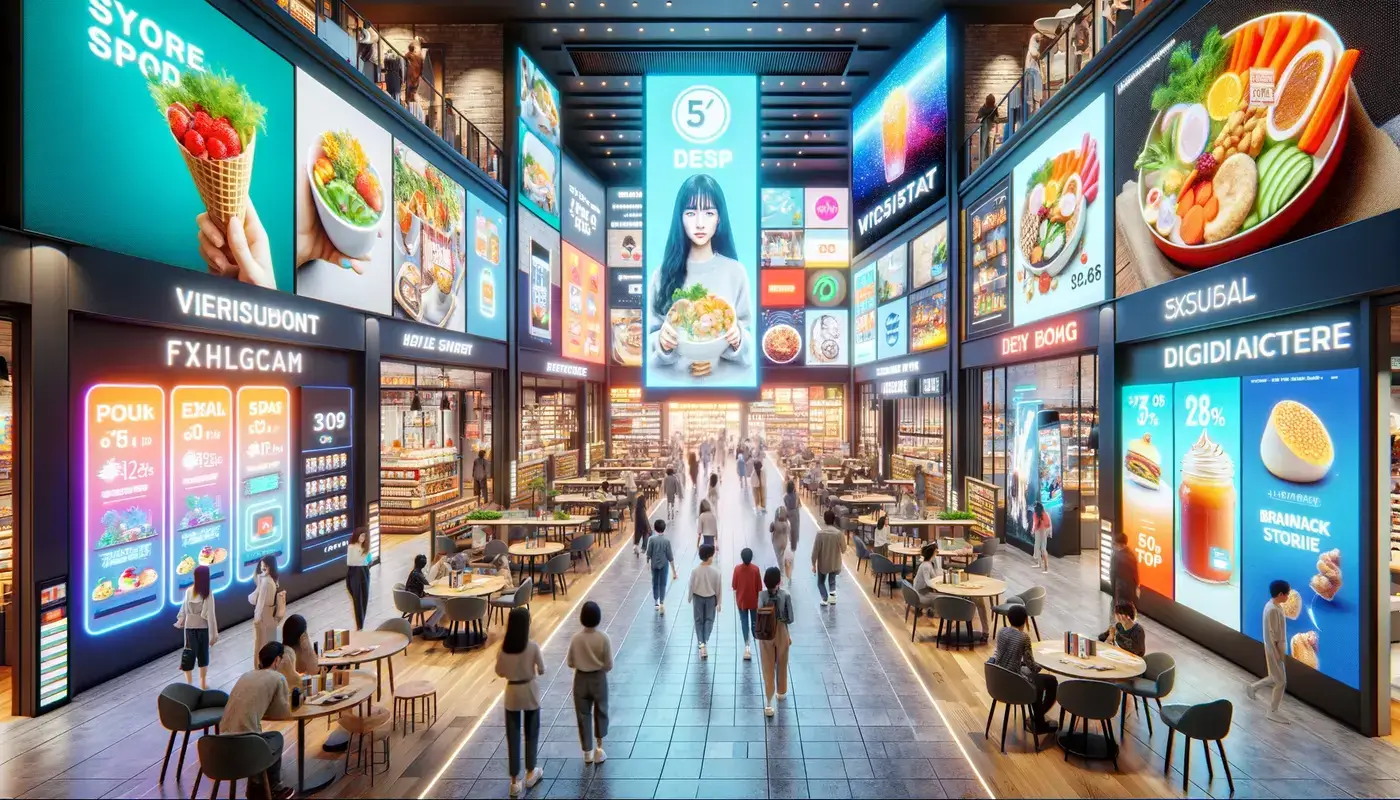Transform Your Business with Digital Signs in UAE Industries
In today’s fast-paced world, capturing the attention of your audience is more critical than ever. Enter digital signs—a versatile and dynamic way to communicate, advertise, and engage. From bustling retail environments to serene corporate offices, digital sign have revolutionized how information is displayed and absorbed. This guide delves into the multifaceted world of digital sign, exploring their benefits, applications, and future trends.

What are Digital Signs?
At its core, a digital sign is an electronic display that showcases multimedia content. Unlike traditional static signs, digital sign can display videos, animations, and dynamic text, making them a powerful tool for modern communication. Typically, digital sign consist of a screen (such as an LED or LCD panel), a media player, and software that controls the content. This combination allows for real-time updates, interactivity, and a higher degree of customization.
History of Digital Signs
The journey of digital signs began with the advent of digital technology in the late 20th century. Early versions were rudimentary, often limited to basic text displays. However, as technology advanced, so did the capabilities of digital sign. The transition from monochrome displays to full-color screens marked a significant milestone, enabling richer and more engaging content. Today, digital sign are ubiquitous, found in a variety of settings from retail stores to corporate offices.
Types of Digital Signs
Digital sign come in various forms, each suited to specific needs and environments. Some common types include:
- LED Displays: Known for their brightness and visibility, even in direct sunlight.
- LCD Screens: Popular for indoor use due to their high resolution and color accuracy.
- Interactive Touchscreens: Allow users to interact directly with the display, ideal for kiosks and wayfinding.
- Video Walls: Composed of multiple screens working together to create a large, cohesive display.
Each type of digital sign offers unique advantages, making it essential to choose the right one for your specific application.
In today’s fast-paced industrial world, communication is key to driving efficiency and productivity. One of the most innovative tools for enhancing communication across industries is the use of digital signs. If you are looking to modernize your business in the UAE, implementing digital signage in industries can offer a powerful way to display critical information, improve brand visibility, and streamline processes in factories, warehouses, and other industrial environments.
At Al Burooj Advertising, we specialize in designing and installing custom digital signage solutions tailored to meet the specific needs of various industries across the UAE. From industrial digital signs in Dubai to commercial digital displays in Abu Dhabi, our expertise can help you transform the way you communicate in your business.

Why Digital Signs Are Essential in Industries
In an industrial setting, digital signs can serve multiple purposes, from conveying safety instructions to sharing production data in real time. Here’s why they are so essential:
- Improved Communication
Digital signs in industries allow businesses to convey real-time updates, safety information, and critical alerts. For instance, an assembly line in a factory can use digital signage to display operational instructions, reducing the need for printed materials or verbal communication. This instant display of information helps employees stay informed and increases overall efficiency. For more details on durable signs, check out our industrial-grade LED digital signs. - Enhanced Branding and Visual Appeal
Whether you operate in Dubai, Abu Dhabi, or Sharjah, incorporating custom digital signs can enhance your company’s brand identity. Digital signs are customizable, allowing you to display your company logo, colors, and branding messages consistently across different locations. For an added touch of elegance, explore our premium metal signs. - Versatility and Customization
One of the greatest advantages of digital signs is their flexibility. Unlike traditional signs, digital signage can be updated remotely, ensuring that the displayed content is always relevant and up-to-date. Whether you need LED digital signs for industries in Dubai or industrial-grade signage for your Sharjah warehouse, we can create solutions that fit your unique requirements.
Types of Digital Signs for Industries
At Al Burooj Advertising, we offer a variety of digital signage solutions to meet the diverse needs of UAE industries. Some of the most popular types include:
- LED Digital Signs
Our LED digital signs are perfect for industrial environments where visibility is key. These signs are energy-efficient and offer bright, clear displays that can be seen from a distance. They are ideal for both indoor and outdoor use, making them suitable for manufacturing plants, warehouses, and other large facilities. - Interactive Digital Signs
In a more technologically advanced environment, interactive digital signs can allow employees to interact with the display, retrieving information on demand. This is particularly useful in industries where data and instructions need to be accessed quickly, such as logistics or inventory management. Our team designs custom interactive signs for businesses across the UAE, helping you improve workflow and engagement. - Outdoor Digital Signs
Our outdoor digital signage solutions are built to withstand harsh weather conditions. These signs are perfect for industries that require large-scale outdoor displays, such as construction or real estate developments. We offer durable and industrial-grade digital signs that can be placed in high-traffic areas to advertise your services or provide directional information. - Digital Signs for Factories
Factories and production facilities often need real-time data displayed for employees, such as production goals, inventory levels, or safety reminders. Our digital signage solutions for factories help improve productivity by providing the right information at the right time. Whether it’s through custom LED signs or larger digital displays, we can ensure that your team stays informed and engaged.
Benefits of Using Digital Signs in UAE Industries
- Efficiency Boost
By automating the communication process, digital signs reduce the need for manual intervention. This not only saves time but also ensures that important updates reach the entire team instantly. Whether you’re managing a factory floor or overseeing a commercial space, digital signs help streamline operations and boost efficiency. - Cost-Effectiveness
While traditional printed signage can become costly due to frequent updates and replacements, digital signage provides a more cost-effective solution in the long run. You can update content remotely with just a few clicks, eliminating the need for physical reprints. Moreover, our energy-efficient LED signs help keep power consumption low, contributing to significant cost savings over time. - Safety and Compliance
In many industries, safety is a top priority. Our digital signs can be used to display important safety information, reminders, and emergency procedures. This not only keeps employees informed but also ensures compliance with safety regulations. For factories, industrial digital signage can display alerts about machinery maintenance, hazardous zones, or safety gear requirements. - Real-Time Data Display
In industries that rely on continuous production or data monitoring, real-time updates are crucial. Our digital signage solutions can be integrated with your existing systems to display live data, performance metrics, or alerts. Whether it’s for a manufacturing facility or a commercial space, real-time information improves decision-making and operational oversight.
Why Choose Al Burooj Advertising?
At Al Burooj Advertising, we pride ourselves on delivering cutting-edge digital signage solutions for a wide range of industries in the UAE. Our team of experts can design, install, and maintain custom digital signs that cater to your specific needs. Whether you need LED digital signs for a factory or interactive displays for a corporate office, we have the expertise to deliver results.
Our dedication to quality and innovation ensures that our digital signs not only meet but exceed your expectations. We provide comprehensive services, from initial consultation to installation, to ensure that your signage project runs smoothly from start to finish. Learn more about our offerings, such as reception signs and directory boards, to further enhance your business communication.
FAQs
What are the benefits of digital signs?
Digital signs offer numerous benefits, including enhanced visibility, dynamic content, real-time updates, and increased engagement. They can be easily customized and are more flexible than traditional signs.
How do digital sign work?
Digital signs typically consist of a display screen, a media player, and software that controls the content. The media player stores and plays the content, which is then displayed on the screen.
What types of digital sign are available?
There are various types of digital signs, including LED displays, LCD screens, interactive touchscreens, and video walls. Each type has its own advantages and is suited to different applications.
How much do digital signs cost?
The cost of digital signs can vary widely depending on factors such as the type of display, the size of the system, and the installation requirements. It’s important to consider both the initial purchase price and ongoing expenses.
Can digital signs be used outdoors?
Yes, outdoor digital sign are designed to withstand the elements and provide high visibility even in direct sunlight. They are commonly used for billboards, public information displays, and storefront advertising.
What should I consider when choosing a digital sign? When choosing a digital sign, consider factors such as the location, purpose, and audience. It’s also important to think about the type of content you want to display and the hardware and software requirements.
Conclusion
Digital sign represent a powerful tool for modern communication, offering a dynamic and flexible way to display information. From retail environments to corporate offices, their applications are vast and varied. By understanding the different types of digital signs, their benefits, and the factors to consider when choosing and maintaining them, businesses can effectively leverage this technology to enhance their communication and engagement efforts.
